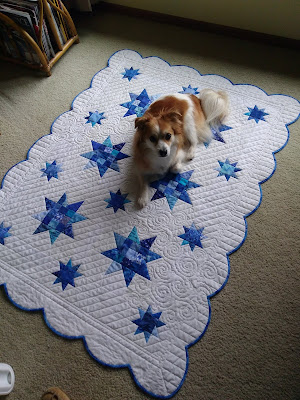I love pieced borders, but I don't always love making them fit! Happily, there are some tricks to making them work.
Here's what I was working on the last couple of weeks.
I wish I had a better picture. The only available quilt holder was busy painting her nails and I decided I didn't want wet nail polish anywhere close to the quilt top! Unfortunately, the deck railing is not a pretty a spot for photos at this time of year. The backdrop is lacking pretty foliage now that the hostas have died back.
My initial plan for this quilt was to stop after a narrow inner white border and bind with a matching green stripe, making a very simple quilt. I was aiming for classic with a hint of modern by matching the border to the background and using the binding as a frame.
I did the math to figure out the size and thought it would work. As I laid out the HST on the design wall, the size looked fine. Of course, once I started sewing all the blocks together those seam allowances, as always, ate up a lot of fabric! Why does this still surprise me? In the end, the quilt center was smaller than I had hoped. The math was right, but my sense of how large those measurements actually are was off. So, extra borders it was.
I decided to make the second border scrappy, in keeping with the center of the quilt. I didn't have any yardage to go with the rest of the fabrics anyway, so that confirmed the scrappy choice!
The challenge was to figure out how wide to make the first white border so that my border of scrappy squares would fit perfectly. Setting the HST on point resulted in a center that wasn't a nice even multiple of any useful measurement, so my inner borders would have to be an odd size to bring the top up to size to fit my pieced border (unless I wanted to cut all the pieces of the pieced border very odd sizes, which I didn't).
Here's how I dealt with it. I didn't worry about a perfect fit to start out. I figured out an approximate border width and rounded up to an easy-to-cut size, and added 1/4" for good measure. I cut the borders to this width, and added them to the quilt. Now I could trim them down to size as needed. It's a lot easier to trim it down than make it larger, which is why I made it larger than I figured it needed to be.
Next, I made sure both my side pieced borders were the same length. Small variations in seam allowance add up and become obvious in a pieced border! I had to take in a few seams by 1/16th or so to shorten one side by about 1/4". I matched the lengths of the top and bottom borders as well.
The next step was to compare the width of the quilt with the length of the pieced top/bottom borders, and the length of the quilt with the length of the pieced side borders. I lay the borders on the quilt:
You can see below that the bottom/top strip was not long enough.
That's OK. Remember, I made those white inner borders wider on purpose! There was a 1/4" difference, so I shaved 1/8"off each white side border (a total of 1/4") to match the length of the bottom/top pieced borders.
What about the pieced side borders?
Whoa! That stuck out rather far! But wait, it was only longer by the amount that the pieced top and bottom border would add to the length. Perfect! If it had stuck out more than that, I would have taken in a few seams on the pieced borders to shorten them. If they had been shorter than that, I would have shaved the difference off the white top/bottom inner borders to bring the quilt's length down to the length of the pieced borders. It would all have fit in the end! Notice that I measured this
before sewing the bottom and top borders on, because if those were attached I would lose the option of shaving fabric off the white top/bottom borders border if needed.
Voilà! Pieced borders were attached and fit perfectly.
At this point the quilt was large enough, but it didn't look quite as airy and light as I had planned. The pieced border hemmed everything in too much. Enter a final white border. Now the pieced border floats and the light airy feel is restored. Well, I think so anyway!
I plan to quilt this one very simply, and the original green striped binding choice will still work. I guess I should go check that I have enough for the new size!






















































